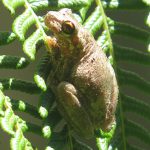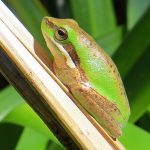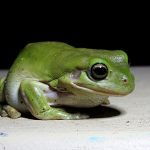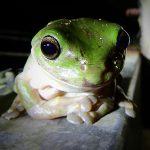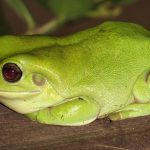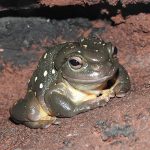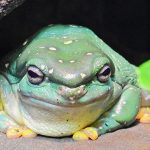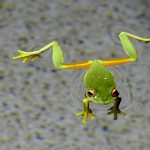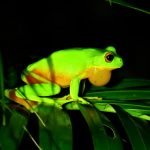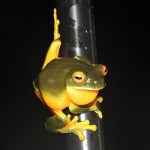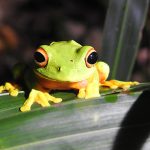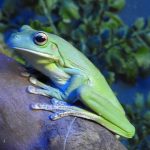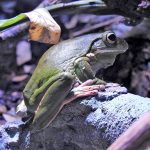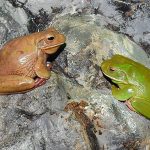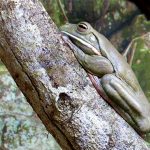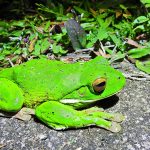AUSTRALIAN TREE FROGS
Tree frogs in Australia are incredibly adaptable and can be found in various habitats, including rainforests, woodlands, urban areas, and suburban gardens. They are equally comfortable in natural environments and human-altered landscapes. They have evolved their colors as a camouflage adaptation, allowing them to blend in seamlessly with the vegetation in their habitats.
Many Tree frogs in Australia are skilled climbers and spend a significant amount of time in trees and vegetation. They use their specialized toe pads to adhere to surfaces and move with ease.
Tree frogs are known for their loud and distinctive calls, which can vary among different species. These calls are essential for communication, especially during the breeding season.
During the daytime, Tree frogs can sometimes be found in communal roosting sites, where several individuals gather in the same location to rest and seek shelter.
Most Tree frogs are nocturnal, meaning they are most active during the night. They hunt for insects and other prey under the cover of darkness.
While Tree frogs are highly adaptable and can be found in various environments, they are still dependent on water for breeding. Females lay their eggs in water bodies, and tadpoles develop and grow in aquatic environments.
Tree frogs play a crucial role in the ecosystem by controlling insect populations and serving as a food source for various predators, contributing to the balance of their respective habitats.
Tree frogs are a prominent and vital part of Australia’s diverse frog fauna. They are loved by many and are often featured in art, literature, and even as popular subjects for pet-keeping in some regions.
Sadly they face challenges in urban areas due to habitat loss and exposure to pollutants.
You can help join the fight to save the frogs !of Australia !
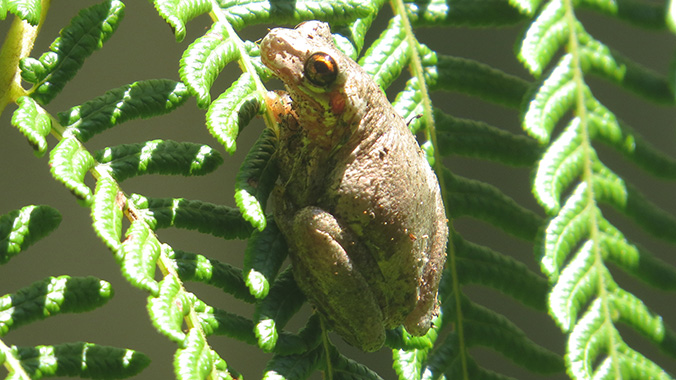
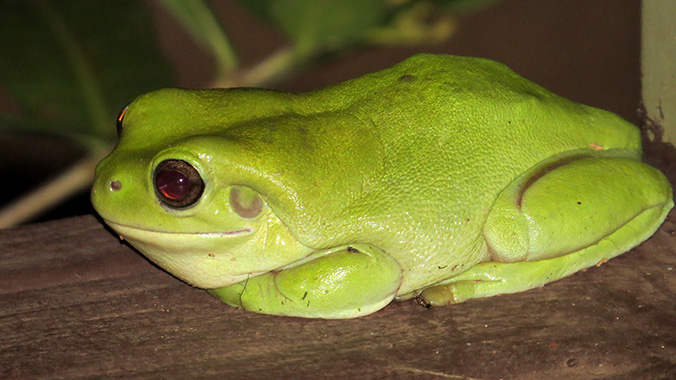
The Bleating Tree Frog (Litoria dentata) is another fascinating Australian frog species belonging to the Hylidae family.
Their vibrant green bodies, often speckled with brown or gold, help them blend seamlessly into their leafy surroundings, providing them with excellent camouflage against predators.
Their coloration can vary, but they are typically shades of brown or green, often with darker patterns and patches. They have large, distinct tympanums (eardrums) on either side of their head.
In terms of size, these frogs are relatively small, typically measuring around 3 to 4.5 centimetres in length. Despite their modest size, they play a significant role in their ecosystem.
The Bleating Tree Frog is native to Australia and can be found in the eastern coastal regions, particularly in New South Wales and southern Queensland.
These frogs are commonly found in wet and moist environments, including rainforests, woodlands, and areas near creeks, swamps, or still water bodies.
Like other tree frogs, Litoria dentata is an arboreal species, spending much of its time in trees and vegetation. They are active at night (nocturnal) and rest during the day.
The name “Bleating Tree Frog” comes from its unique call, which resembles the bleating sound of a sheep or lamb. Their call is a series of repeated, nasal “baa-baa” or “craak-craak” sounds.
The diet of Bleating Tree Frogs mainly consists of insects, such as crickets, moths, and other small invertebrates.
Breeding typically occurs during the warmer months, and the females lay their eggs in ponds or other water bodies. The tadpoles hatch from the eggs and undergo metamorphosis to become adult frogs.
The Green Tree Frog (Litoria caerulea) is one of Australia’s most well-known and iconic frog species. It is a large, colorful tree frog found in various parts of Australia, including the eastern coastal regions and the northern parts of the country.
It is known for its striking emerald-green color, which can vary in intensity and may also include yellow or blue tones. They have a plump body with a white or cream-colored underside and distinctive golden eyes with horizontal pupils.
Adult Green Tree Frogs can grow to be around 6 to 10 cm in length, making them a relatively large species among Australian frogs.
These frogs are highly adaptable and can be found in a wide range of habitats, including rainforests, woodlands, urban areas, and suburban gardens. They are commonly seen near water sources, such as ponds, creeks, and wetlands.
As their name suggests, Green Tree Frogs are arboreal, which means they spend a significant portion of their time in trees and vegetation. They have adhesive toe pads that help them grip onto surfaces, making them skilled climbers.
Green Tree Frogs are carnivorous and primarily feed on insects, spiders, and other small invertebrates. They use their long, sticky tongues to catch prey.
Breeding typically occurs during the warmer months of the year, from spring to summer. Females lay their eggs in water, such as ponds or swamps, where the tadpoles develop and eventually metamorphose into adult frogs.
Like many frog species, Green Tree Frogs are known for their distinct calls, which are often described as a loud, musical “craaaak-craaaak” sound. Males use these calls to attract females and establish territories.
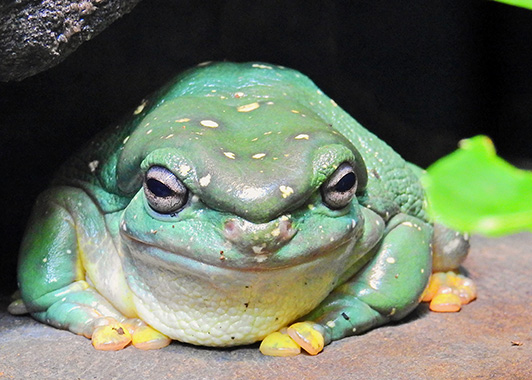
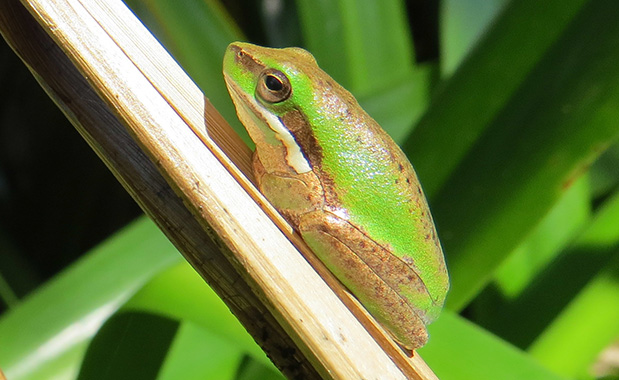
The Magnificent Tree Frog (Ranoidea splendida) is a species of tree frog found in parts of northern and eastern Australia.
The Magnificent Tree Frog is appropriately named due to its splendid and eye-catching colors. It has a bright green or lime green body with patches of yellow or gold, often edged with black markings. Its large eyes have horizontal pupils, and its toes are equipped with adhesive pads, enabling it to climb and stick to various surfaces.
The Magnificent Tree Frog is native to Australia and is commonly found in the northern regions of Queensland and the eastern coastal areas, including parts of New South Wales.
This tree frog prefers a variety of habitats, such as rainforests, wet sclerophyll forests, and vine thickets. They are often seen perched on vegetation or trees near water sources, where they breed.
Like most tree frogs, Ranoidea splendida is primarily nocturnal, becoming active at night to forage for insects and other small prey. During the day, they seek shelter in vegetation or tree hollows.
The Magnificent Tree Frog is known for its loud and melodious call, which is often described as a series of “wark-wark” or “ark-ark” sounds. Males use these calls to attract females and establish territory.
These frogs are insectivores and mainly feed on a diet of insects, spiders, and other small invertebrates.
Breeding typically occurs during the warmer months, from spring to summer. Females lay their eggs in water bodies like ponds, creeks, or puddles, where the tadpoles develop and eventually metamorphose into adult frogs.
The Cascade Treefrog (Litoria pearsoniana) is native to the eastern coast of Australia, where it is found in various parts of Queensland and New South Wales. Its range extends from the rainforests of north-eastern Queensland to the eastern coastal regions of New South Wales.
The Cascade Treefrog is a relatively small species with a slender body. Its coloration can vary, but it is generally green or brown with darker patches and patterns. It has a distinctive dark stripe that runs from its nostril to the shoulder.
As its name suggests, this frog is commonly found in or near cascading waterfalls, rocky streams, and other freshwater bodies. It prefers moist and humid environments, such as rainforests, where it can find suitable breeding sites.
Litoria pearsoniana is an arboreal frog, meaning it spends much of its time in trees and vegetation. However, it can also be found on the ground near water sources. Like many tree frogs, it is nocturnal, becoming more active at night.
Cascade Treefrogs are known for their distinctive call, which is a series of rapid, high-pitched whistles or peeping sounds. These calls are used for communication and during the mating season to attract potential mates.
Their diet mainly consists of insects and other small invertebrates that they can find in their habitat, including ants, beetles, and spiders.
During the breeding season, females lay their eggs on rocks or vegetation near flowing water. The tadpoles hatch from the eggs and develop in the water until they undergo metamorphosis into adult frogs.
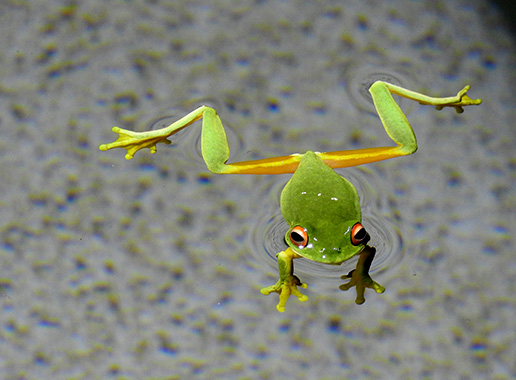
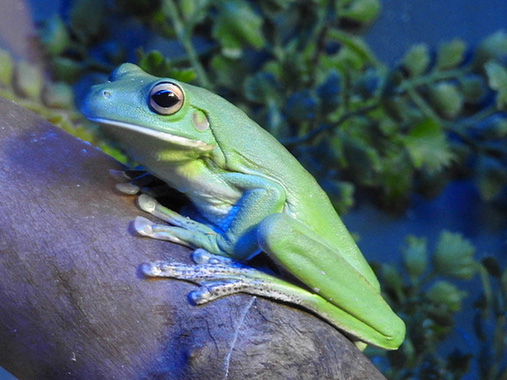
The Orange-thighed Frog (Ranoidea xanthomera) is endemic to the Wet Tropics region in northern Queensland. It has a restricted range and is found in specific habitats within this area.
As the name suggests, the Orange-thighed Frog is characterized by its bright orange or yellow-colored thighs. Its overall coloration can vary, but it is typically green or brown with darker markings. It has large eyes with horizontal pupils, which are common characteristics of tree frogs.
This species is primarily found in rainforests and other moist habitats within its limited range. They are arboreal frogs, meaning they spend much of their time in trees and vegetation.
The Orange-thighed Frog is nocturnal and active at night. They are skilled climbers and use their adhesive toe pads to cling to foliage and trees.
Like many tree frogs, Ranoidea xanthomera produces a variety of calls, including trills, clicks, and chirps. Their calls are used for communication, especially during the breeding season.
These frogs are insectivores and primarily feed on small insects and invertebrates found in their habitat.
Breeding usually occurs during the wet season when there is an abundance of water in their habitat. Females lay their eggs in water bodies, and the tadpoles develop in the water until they undergo metamorphosis into adult frogs.
The Orange-thighed Frog is classified as a vulnerable species due to its restricted range and the potential threats it faces, such as habitat loss and degradation.
Given that the Orange-thighed Frog has a limited distribution and is considered vulnerable, conservation efforts are essential to protect its habitat and ensure its survival in the wild.
The White-lipped Tree Frog (Nyctimystes infrafrenatus) is a large and eye-catching frog species found in various parts of Australia, Papua New Guinea, and nearby islands
The White-lipped Tree Frog is known for its impressive size and distinctive appearance. It has a robust body, large limbs, and a broad head. The upper body coloration varies from bright green to olive, and it often has irregular patterns and markings. As the name suggests, it has a characteristic white or cream-colored lower lip, which is one of its key identifying features.
The White-lipped Tree Frog is native to a wide range of locations, including parts of north-eastern Australia, Papua New Guinea, the Solomon Islands, and other nearby islands in the south-western Pacific region.
These frogs are typically found in moist and humid environments, such as tropical rainforests and wet sclerophyll forests. They are excellent climbers and are often seen perched on vegetation or tree branches near water bodies.
Nyctimystes infrafrenatus is mostly nocturnal, becoming active at night to hunt for insects and other small prey. During the day, they seek shelter in the vegetation or under the bark of trees.
The White-lipped Tree Frog is well-known for its loud and distinctive calls, which are described as a series of “wark-wark-wark” or “baa-baa” sounds. Males produce these calls to attract females and establish their territory.
Their diet mainly consists of insects, spiders, and other small invertebrates that they can find in their habitat.
Breeding typically occurs during the wet season when there is an abundance of water in their habitat. Females lay their eggs in water bodies like ponds, slow-moving streams, or swamps. The tadpoles hatch from the eggs and develop in the water until they undergo metamorphosis into adult frogs.
Loveridge’s frog (Philoria loveridgei)
In the lush, verdant rainforests of Northern New South Wales, there exists a tiny marvel of nature that often goes unnoticed due to its remarkable camouflage.
It is listed as a threatened species Schedule 1 of the Act .
This diminutive creature, measuring just about 15 millimetres in length, is likely the *Moss Froglet* (*Philoria loveridgei*).
The Moss Froglet is a master of disguise, its mottled green and brown skin resembling the soft, damp mosses that blanket the forest floor. This clever adaptation not only helps it avoid predators but also allows it to blend seamlessly into its environment, making it a challenge to spot even for the most observant nature enthusiast.
Imagine walking through the rainforest, the air thick with the scent of wet earth and the gentle patter of rain on leaves. The chorus of frogs fills the air, a symphony of croaks and calls, yet the Moss Froglet remains silent and still, relying on its appearance rather than sound to communicate its presence.
These frogs are an essential part of the rainforest ecosystem, contributing to the balance by consuming small insects and, in turn, serving as prey for larger animals. Their existence is a delicate reminder of the interconnectedness of life within these ancient forests.
The Moss Froglet’s habitat is under constant threat from human activities and climate change, making conservation efforts crucial to ensure its survival. By protecting the rainforests of Northern New South Wales, we can help preserve the intricate web of life that supports these extraordinary creatures.

